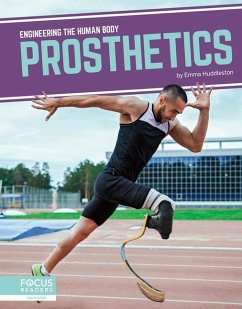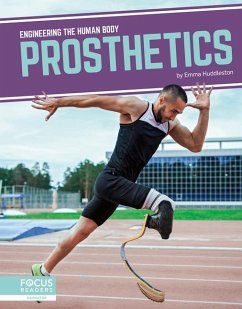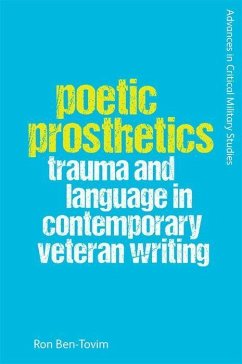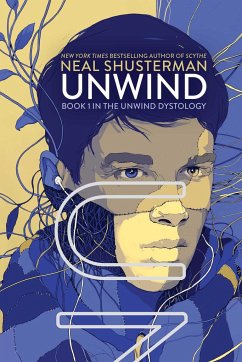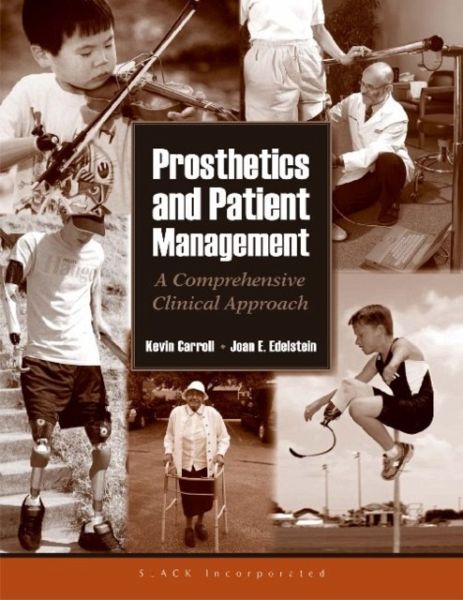
Prosthetics and Patient Management
A Comprehensive Clinical Approach
Versandkostenfrei!
Versandfertig in 1-2 Wochen

PAYBACK Punkte
50 °P sammeln!




Covering both upper and lower extremity prosthetics, this book provides practical solutions to everyday problems that clinicians encounter, from early prosthetic management to issues facing advanced prosthetic user. It is useful for clinicians and students in physical therapy and certified prosthetists, as well as orthopedists.
Kevin M Carroll, MS, CP, FAAOP has a simple guiding philosophy: people first. This has served him well in his clinical consultations with thousands of prosthetic consumers across the World. By listening to each person's thoughts and concerns, and understanding their unique situations, Kevin has found a sure path to assisting people in their rehabilitation. He specializes in the care of older adults and also has a degree in gerontology, enhancing his expertise in this area. Kevin's practice began in his native country of Ireland in 1978 at the National Medical Rehabilitation Center in Dublin. In 1984, he moved to the United States and continued his education, earning degrees in Family Studies, Gerontology, and Counseling Psychology. He serves as Vice President of Prosthetics for Hanger Prosthetics & Orthotics, the largest provider of prosthetic care in the World. Kevin's commitment to improving prosthetics has placed him at the forefront of numerous prosthetic breakthroughs. His professional background encompasses the roles of researcher, educator, international speaker, and clinician. Kevin travels extensively throughout North America and various parts of the World presenting continuing education courses at professional conferences, and conducting Patient Evaluation Clinics. He is certified by the American Board for Certification as a Certified Prosthetist and has been named a Fellow of the American Academy of Orthotics and Prosthetics, one of the highest honors of the profession. Professional contributions include Practitioner Advisory Council for O&P Business News; Editorial Advisory Board for Orthopedic Technology Review; Editorial Board for Jointe Centre for Research in Prosthetics & Orthotics and Rehabilitation Programs, Kingdom of Saudi Arabia; Professional Advisory Board for O&P Edge; and Editorial Board of O&P Business World. Kevin has written on all aspects of prosthetics for publications such as Physical Medicine and Rehabilitation Clinics of North America, American Academy of Orthopaedic Surgeons, Foot and Ankle Clinics of North America, Amputee Coalition of America, and various magazine articles. He is a member of the International Society for Prosthetics and Orthotics, and is a professional advisor for the Amputee Coalition of America, and a member of the National Association of Professional Geriatric Care Managers; Kevin is also a member of the British Association of Prosthetics and Orthotics (BAPO). Kevin's hobbies include playing music and building sport prosthetic systems, and watching athletes put them to the test at track and field events and the Paralympics. Joan E. Edelstein, MA, PT, FISPO, is a world-renowned authority in prosthetics and orthotics. After graduating from New York University, NY, magna cum laude, she entered clinical practice in the Children's Division of the Institute of Physical Medicine and Rehabilitation, subsequently renamed the Rusk Institute of New York University, where she became chief physical therapist. When invited to join the faculty of the University of Wisconsin, Madison, she began the academic phase of her career. Returning to New York, she became a senior research scientist at New York University's Prosthetics and Orthotics Program, originally part of the College of Engineering, later a division of the Department of Orthopedic Surgery and the School of Education. She conducted laboratory and field-testing of a wide variety of prostheses and orthoses for the upper and lower limbs, as well as trunk orthoses. She is highly regarded for her enthusiastic instruction in the postgraduate courses offered to physicians, prosthetists, therapists, and other members of the rehabilitation team. Professor Edelstein pioneered the establishment of the first undergraduate curriculum leading to the baccalaureate in prosthetics and orthotics. Upon the closing of the New York University program, she became an associate professor of clinical physical therapy at the College of Physicians and Surgeons, Columbia University, New York, NY, and served as Director of the Program in Physical Therapy. She continues as Special Lecturer at Columbia University and adjunct faculty at New York University; George Washington University, Washington, DC; Touro College, Bay Shore, NY; and Husson College, Bangor, ME. Professional contributions beyond the university include presenting post-graduate and continuing education courses throughout North America, Europe, Africa, Asia, and the Middle East. She has been a keynote speaker at professional conferences and congresses. Her numerous publications pertaining to all phases of prosthetics and orthotics include journal articles, book chapters, monographs, and books, particularly Orthotics: A Comprehensive Clinical Approach (published by SLACK Incorporated). Professor Edelstein has been editor or member of the editorial boards of Archives of Physical Medicine and Rehabilitation, Journal of the Association of Children's Prosthetic-Orthotic Clinics, Journal of Rehabilitation Research and Development, Physical and Occupational Therapy in Geriatrics, and Topics in Geriatric Rehabilitation. She was honored by being named a Fellow of the International Society for Prosthetics and Orthotics.
Produktdetails
- Verlag: SLACK Incorporated
- Seitenzahl: 284
- Erscheinungstermin: 1. Juni 2006
- Englisch
- Abmessung: 286mm x 221mm x 20mm
- Gewicht: 1014g
- ISBN-13: 9781556426711
- ISBN-10: 1556426712
- Artikelnr.: 22212850
Herstellerkennzeichnung
Libri GmbH
Europaallee 1
36244 Bad Hersfeld
gpsr@libri.de
Für dieses Produkt wurde noch keine Bewertung abgegeben. Wir würden uns sehr freuen, wenn du die erste Bewertung schreibst!
Eine Bewertung schreiben
Eine Bewertung schreiben
Andere Kunden interessierten sich für









